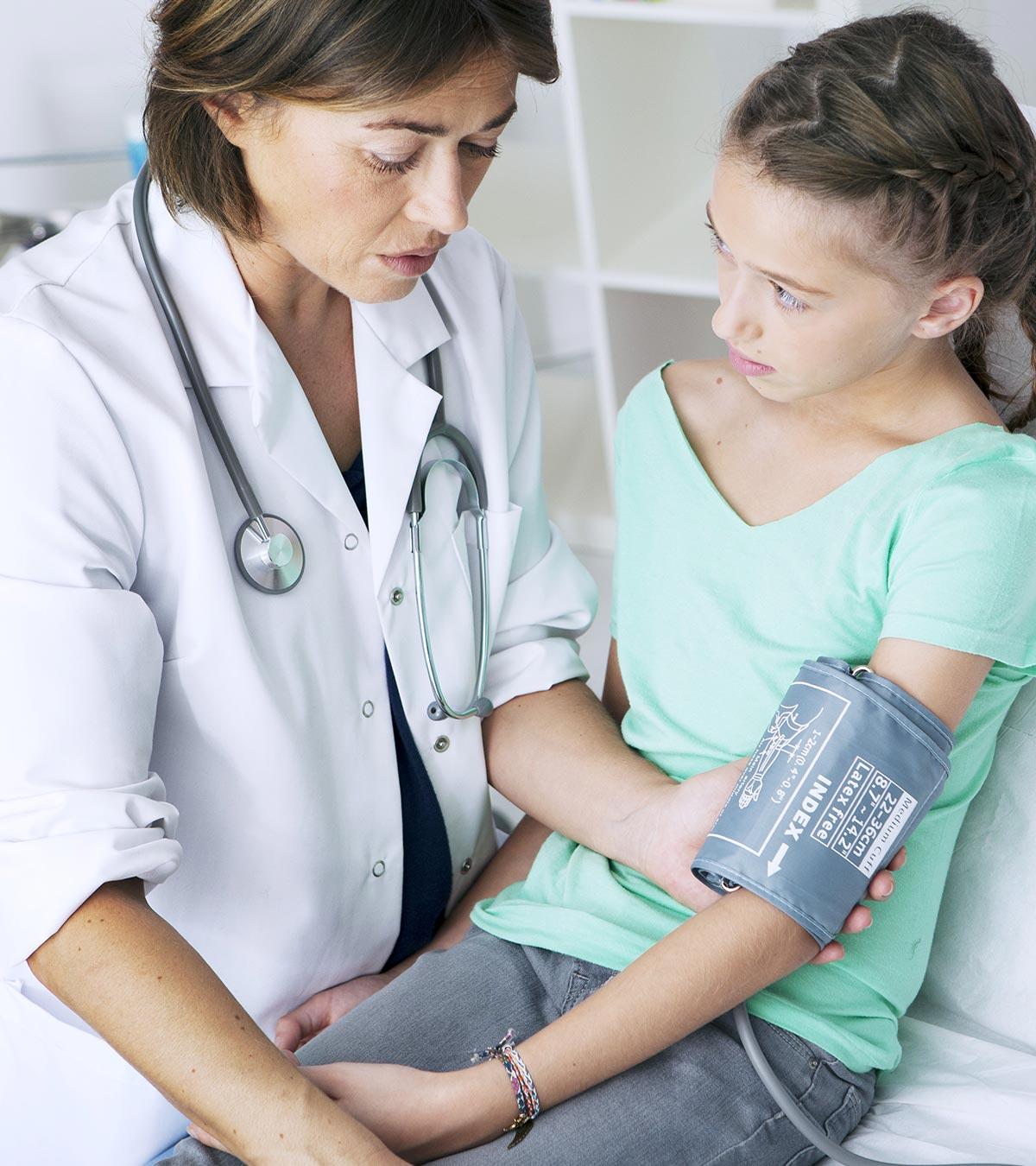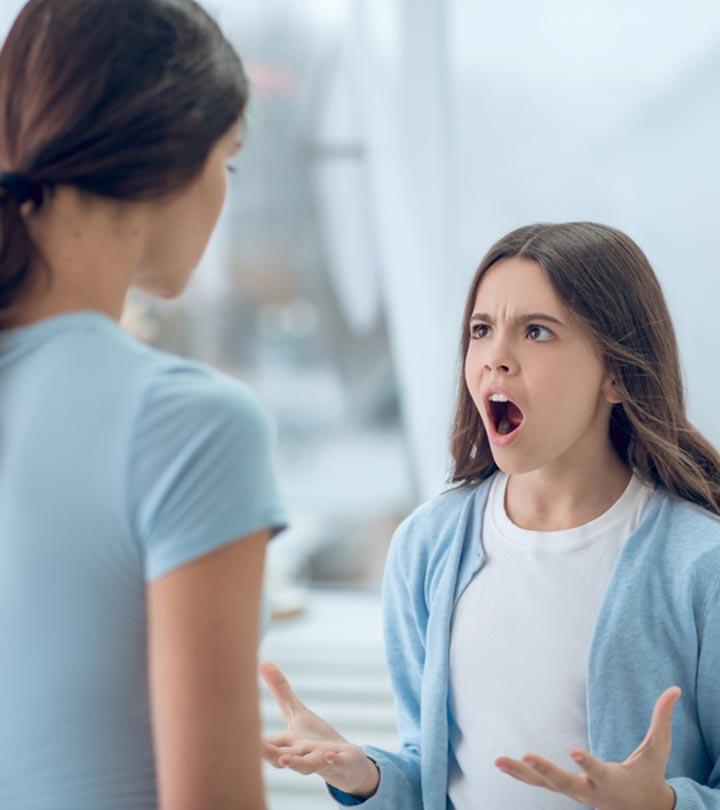
Image: Shutterstock
Pink eye (conjunctivitis) in kids is a common eye infection among those younger than five years (1). This condition causes inflammation of the membrane covering the eyeball and the inside of the eyelid (conjunctiva). Viral or bacterial infections and allergic reactions can cause pink eyes in children. Infectious conjunctivitis is highly contagious, and there can be large outbreaks in schools or daycare centers (2). Teaching hand hygiene and not rubbing eyes with unwashed hands may help to reduce the incidence of conjunctivitis.
Read on to know the causes, symptoms, treatment, home remedies, and preventive measures for pink eye (conjunctivitis) in kids.
What Does Pink Eye Look Like?
Image: Shutterstock
The sclera or the white of the eye may look red or pink with an absence of any eye injury. It may appear irritated, and the child may have a watery eye.
Image: Shutterstock
The eyelids may appear mildly puffy or swollen with or without a discharge (3).
Types Of Conjunctivitis In Children
There are various types of conjunctivitis. Some of the common ones to affect children are the following (3) (4) (5) (6).
- Viral conjunctivitis: It is caused by viruses, and the eye may become itchy and red without pus. The discharge is watery and not thick. It usually affects one eye but may spread to the other eye, too. The majority of viral infections are mild but highly contagious. It may also be a result of a cold or flu. It can be associated with upper respiratory tract infection.
- Bacterial conjunctivitis: The bacteria may cause the eye to become red, itchy, swollen, and painful. One or both eyes could get affected, and the child may experience discharge of pus, which may make the eyes stick together. Bacterial conjunctivitis can also occur with an ear infection. It can become invasive and cause infection in the tissue around the eye.
- Irritant conjunctivitis: The eye may become pink and watery after it comes in contact with an irritant. The child may also experience mucus discharge.
- Allergic conjunctivitis: This usually occurs in both eyes and can lead to intense itching, swelling, and tearing. The child may also experience nasal symptoms such as an itchy nose, sneezing, a scratchy throat, or asthma.
Causes Of Conjunctivitis In Children
The cause varies as per the type of conjunctivitis. Below are some of the common causes of pink eye (2) (4).
- Virus:
- Adenoviruses
- Herpes virus
- Bacteria:
- Staphylococcus aureus
- Haemophilus influenzae
- Streptococcus pneumoniae
- Neisseria gonorrhoeae
- Chlamydia trachomatis
- Moraxella catarrhalis
- Allergens:
Image: IStock
- Pollen from trees, plants, or grass
- Dust mites
- Molds
- Dander from pets
- Medicines
- Cosmetics
- Irritants:
- Sunscreen
- Soap
- Chlorine (in a swimming pool)
- Smoke
- Smog
- Dust
- Fumes
- Chemicals
Is Pink Eye Contagious?
Conjunctivitis or pink eye caused by bacteria or virus is contagious, while allergic and irritant conjunctivitis is non-contagious.
In the case of bacterial conjunctivitis, it can spread when symptoms appear or as long as the eye discharge is present. Viral conjunctivitis can be contagious even before the symptoms appear and as long as the symptoms last.
Symptoms Of Pink Eye In Children
Image: IStock
Symptoms of pink eye may vary according to the cause of infection and include the following (1) (2) (6).
- Pink or red sclera (one or both eyes)
- Swelling of the eyelid (puffiness)
- Crusting or sticking together of eyes in the morning
- Discharge of yellow/green pus, mostly seen in bacterial infection
- Ear infection, often in bacterial conjunctivitis
- Signs of a runny nose, sore throat, flu, or respiratory problems
- Irritation, sensitivity and burning of the eyelid
- Signs of an allergy and discomfort, such as a scratchy nose, itchy throat, sneezing, or asthma
- Stringy discharge from the eye, often seen in allergic conjunctivitis
- Photophobia (unable to tolerate bright light or pain when exposed to bright light)
- Excessive watery or teary eyes
- Dusty or gritty feeling in the eye (sensation of something stuck in the eye)
- Burning sensation in the eyes
When To See A Doctor?
See a doctor promptly if the following conditions exist (1)(7).
- Severe pain in the eyes
- Symptoms of bacterial conjunctivitis that do not improve 24 hours after antibiotic administration
- Blurred or other problems with the vision
- Severe redness in the eye
- Excessive swelling, puffiness, and redness around the eyes and eyelid
- A white spot in the cornea
- Flu-like symptoms such as fever and cold and breathlessness (respiratory problems)
 Quick fact
Quick factHow Is Pink Eye Diagnosed?
The doctor will assess the symptoms, conduct a physical examination, and ask about the medical history of the patient. In some cases, a sample of the eye discharge could be collected to determine the cause. A blood test might be conducted to confirm or rule out other problems(2).
Pink Eye Treatment For Children
The treatment for pink eye is not always necessary. In some cases, medical care is required, and it could vary depending on the child’s symptoms, age, and cause of conjunctivitis (2) (7).
- Bacterial conjunctivitis: Mild cases of bacterial conjunctivitis may not require any antibiotic treatment and may subside in two to five days. However, in some cases, it may take up to two weeks. To reduce complications, prevent the spread to others, and reduce infection time, the doctor may recommend antibiotic drops or ointments.
- Viral conjunctivitis: Most cases of viral conjunctivitis are mild, and the infection subsides on its own within seven to 14 days. In some cases, it may take up to three weeks to subside. Viral conjunctivitis cannot be treated with antibiotics. The doctor may prescribe antivirals to treat infection caused by herpes simplex virus or varicella-zoster virus.
- Allergic conjunctivitis: Symptoms usually improve as soon as the allergen is removed from contact. In some cases, allergy medications and topical eye drops, including topical antihistamine and vasoconstrictors, can provide relief. The doctor may also recommend prescription eye drops or a combination of drugs to reduce the symptoms.
Image: Shutterstock
How Can You Help Your Child Feel Better?
In mild cases, gently cleaning the eyes with cotton balls soaked in warm water can offer relief. However, avoid cleaning the inside of the eyelids since it may damage the conjunctiva. The use of lubricating eye drops or artificial tears may also alleviate the symptoms, but consult a doctor before using them (1).
 Point to consider
Point to considerHome Remedies For Pink Eye In Children
Viral conjunctivitis does not require any medication and can be healed at home with self-care. Bacterial conjunctivitis may require prescribed antibiotics from the doctor. During home treatment, special precautions must be taken to make sure that it does not spread to others.
You may try the following home remedies for pink eye. However, make sure to consult your doctor before taking over-the-counter medications (3) (8).
- Place a cold cloth (compress) over the eyes for a few minutes to reduce inflammation. Make sure the cloth is washed before use.
- Use a warm damp cloth to remove the eye discharge or pus that may lead to sticking of the eyes.
- You may use lubricating eye drops (artificial tears) to make the child feel better. However, use them after cleaning the eye.
- When using eye drops, make sure your child lies down and closes their eyes for about two minutes after the use of medication.
Zibby Owens, a mother of four, recounts her experience with her daughter’s pink eye and the measures she took to alleviate her discomfort. She says, “The next morning, my daughter woke up and said, perplexed, at the top of the stairs, ‘Mama, my eye feels a little funny.’ Uh-oh. I bounded up the steps only to find her right eye completely encrusted. Pink eye. She was blinking repeatedly and purposefully as if the motion would somehow cause the thick layer of crust to magically disappear… I applied wet compresses to my daughter’s eye and pumped her with Motrin (i).”
Can Kids Go To School With Pink Eye?
The decision to keep a child at home depends on various factors, such as the type of pink eye (bacterial, viral, or allergic), degree of symptoms, and school policy (5). The following are some salient points to consider.
- Since bacterial and viral conjunctivitis are contagious, it is advised to keep the child isolated. In allergic conjunctivitis, the child can continue their activities with certain precautions.
- The school policy is a vital factor. Many schools have a policy that a doctor’s approval is mandatory. The child may return to school 24 hours after receiving antibiotic drops treatment for conjunctivitis.
How To Prevent Pink Eye In Children?
You may follow these precautions for prevention of the spread of pink eye in children (1) (8) (9).
- Teaching your child not to share a towel or any cloth with a potentially infected person.
- Not sending your child to daycare or school if there is an outbreak of conjunctivitis.
- Not sharing anything that touches the eyes.
- Always using a clean tissue to clean the eyes and discard the tissue. Never clean the eyes or rub it with a finger.
- Handwashing with soap and water for 20 seconds after coming from outdoors.
- Avoiding potential allergens and irritants.
 Quick tip
Quick tipFrequently Asked Questions
1. Is pink eye related to COVID-19?
According to the American Academy Of Ophthalmology, around one to three percent of COVID-19-affected people may develop pink eye with other symptoms (10).
2. How long can conjunctivitis pathogens live on surfaces?
The duration depends on the causative agent and the type of surface. A bacterial agent may live on a surface for two to eight hours, with certain bacteria surviving for around two days or more. On the other hand, viruses can live for one to two days, with a maximum duration of eight weeks for some viruses (11).
3. How soon do symptoms of pink eye in children typically appear?
Symptoms of bacterial pink eye in children typically appear 24 to 72 hours after exposure. On the other hand, the development of symptoms for viral conjunctivitis might range from 12 hours to 12 days following infection (12).
4. How can parents tell the difference between pink eye and other eye problems in children?
Several conditions may cause symptoms such as redness, itchiness, watery eyes, and crusty eyelids similar to a pink eye. So, it is better to consult a doctor upon the appearance of such symptoms to know the exact diagnosis.
5. Is it possible for a child to get a pink eye more than once?
Yes, a child can acquire a pink eye more than once. Since viruses or bacteria cause the condition, recurring episodes can occur as a result of new infections or reinfection with the same microbe (13).
Pink eye (conjunctivitis) in kids is a common illness caused by bacterial and viral infections or exposure to allergens and irritants. In some cases, the condition self-resolves and requires no treatment. However, some other cases may require cause-dependent medical intervention to get symptomatic relief and avert complications. Placing a cold compress over the eyes for a few minutes and administering eye drops under medical guidance can offer relief. In addition, avoid cleaning the eye discharge with your fingers and sharing things that touch the eyes to help prevent spreading the infection.
Infographic: Can Conjunctivitis Cause Permanent Eye Damage?
Severe allergic or infectious conjunctivitis lasting long periods can lead to complications such as secondary infections and changes in the eye. Go through the infographic to know the common complications of severe conjunctivitis in children. Illustration: Momjunction Design Team
Key Pointers
- Pink-eye causes its sclera to turn pink, making them look swollen, watery, and irritated.
- The infection may be caused by viruses, bacteria, allergens, or irritants.
- Sticking of the eyes, yellow or green discharge, ear infection, and running nose are some symptoms of pink-eye.
- Consult a doctor if there is severe pain or redness, blurred vision, fever, or breathlessness.
Image: Dall·E/MomJunction Design Team
Personal Experience: Source
MomJunction articles include first-hand experiences to provide you with better insights through real-life narratives. Here are the sources of personal accounts referenced in this article.
i. The big sick: my daughter’s eye infection taught me that old-fashioned fun is the best of all;https://zibbyowens.medium.com/the-big-sick-my-daughters-eye-infection-taught-me-that-old-fashioned-fun-is-the-best-of-all-f6433e2c618
References
1. Conjunctivitis; The Royal Children’s Hospital Melbourne
2. Conjunctivitis in children; Stanford Children’s Health
3. Eye-red without pus; Children’s Hospital Colorado
4. Pink Eye: Causes and How It Spreads; Centers for Disease Control and Prevention
5. Heidi Roman, Do I need to keep my son home if he has pinkeye?; American Academy of Pediatrics
6. Symptoms of Pink Eye; Centers for Disease Control and Prevention
7. How to Treat Pink Eye; Centers for Disease Control and Prevention
8. Gudgel D.T., Quick home remedies for pink eye; American Academy of Ophthalmology
9. Pink eye (conjunctivitis); Caring for Kids
10. Is pink eye a symptom of Covid-19; Health University of Utah
11. How long can pink eye “live” on surfaces; American Academy of Ophthalmology
12. Conjunctivitis (Pink Eye); Disease Outbreak Control Division
13. If I get conjunctivitis once can it come back?; American Academy of Ophthalmology
Read full bio of Dr. Elna Gibson
Read full bio of Rebecca Malachi
Read full bio of Shinta Liz Sunny











_in_children_13_symptoms__treatment_illustration.jpg.webp)














